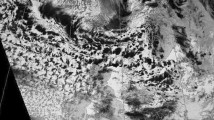Abstract
A simple exponential expression, based upon a form of the Kazanski-Monin stability parameter, modified to account explicitly for effects of surface roughness, and semi-empirically derived from both qualitative and quantitative observations, is presented that relates windspeed and sensible heat flux density to Pasquill stability class. The method, though simple in mathematical form, gives results consistent with physical intuition and reproduces, quantitatively, the essential features of previously published nomograms with an added capability for treating all stability classes and any surface roughness from 0.10 to 100 cm. For the stable classes, a new expression for the wind profile stability factor, predicted by similarity theory, is introduced that produces results more consistent than the more common linear form.
Similar content being viewed by others
References
Barad, M. L.: 1959, Project Prairie Grass, A Field Program in Diffusion, Vol II, Technical Report, AFCRL-TR-58–235, U.S. Air Force Geophysics Laboratory, Bedford, MA.
Deardorff, J. W. and Willis, G. E.: 1975, ‘A Parameterization of Diffusion in the Mixed Layer’, J. Appl. Meteorol. 14, 1451–1458.
Golder, D.: 1972, ‘Relations Among Stability Parameters in the Surface Layer’, Boundary-Layer Meteorol. 3, 47–58.
Hansen, F. V.: 1979, Engineering Estimates for the Calculation of Atmospheric Dispersion, Technical Report, U.S. Army Atmospheric Sciences Laboratory, White Sands Missile Range, NM.
Hansen, F. V.: 1980, Flux-Profile Relationships for Development of Standards of Comparison, Technical Report, U.S. Army Atmospheric Sciences Laboratory, White Sands Missile Range, NM.
Pasquill, F.: 1974, Atmospheric Diffusion, Wiley and Sons, New York.
Paulson, C. A.: 1970, ‘The Mathematical Representation of Wind Speed and Temperature Profiles in the Unstable Atmospheric Surface Layer’, J. Appl. Meteorol. 12, 857–861.
Smith, F. B.: 1972, A Scheme for Estimating the Vertical Dispersion of a Plume from a Source Near Ground Level, Proceedings of the Third Meeting of the Expert Panel on Air Pollution Modeling, Paris, France, October 2–3, 1972.
Smith, F. B.: 1979, ‘The Relation Between Pasquill, Stability P and Kazanski-Monin Stability Μ (in Neutral and Unstable Conditions)’, Atmos. Environ. 13, 879–881.
Sutherland, R. A. and Bach, W. D.: 1984, Significance of Windspeed Surface Roughness, and Sensible Heat Flux Density in Determining Pasquill Stability Category, Proceedings of the Fifth Annual EOSAEL/TWI Conference, Physical Science Laboratory, New Mexico State University, Las Cruces, NM.
Sutherland, R. A.: 1980, ‘A Short Range Objective Nocturnal Temperature Forecasting Model’, J. Appl. Meteorol. 19, 247–255.
Tagliazucci, M. and Nanni, T.: 1983, ‘An Atmospheric Diffusion Classification Scheme Based on the Kazanski-Monin Stability Parameter’, Atmos. Environ. 17, 2205–2211.
Venkatram, A.: 1980, ‘Estimating the Monin-Obukhov Length in the Stable Boundary Layer for Dispersion Calculations’, Boundary-Layer Meteorol. 19, 481–485.
Author information
Authors and Affiliations
Rights and permissions
About this article
Cite this article
Sutherland, R.A., Hansen, F.V. & Bach, W.D. A quantitative method for estimating Pasquill stability class from windspeed and sensible heat flux density. Boundary-Layer Meteorol 37, 357–369 (1986). https://doi.org/10.1007/BF00117483
Accepted:
Issue Date:
DOI: https://doi.org/10.1007/BF00117483




